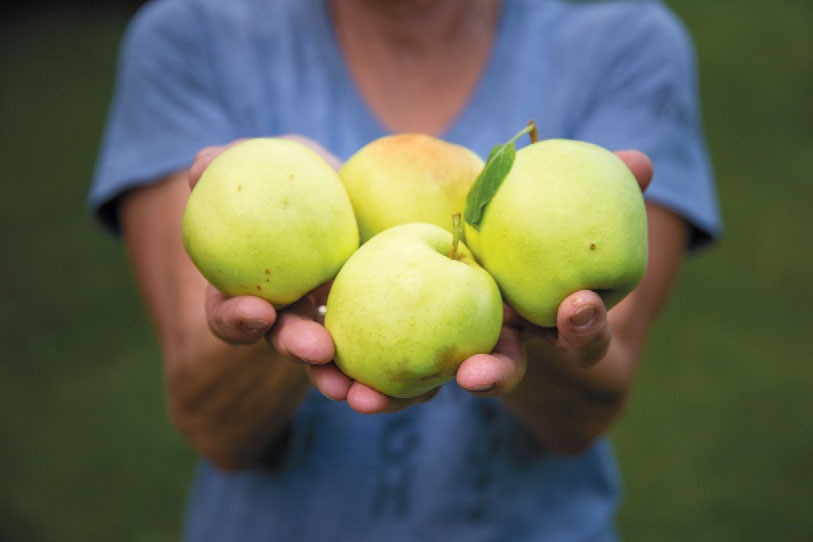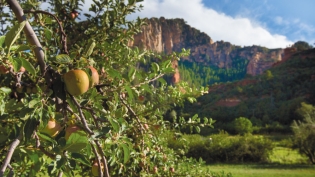Primer of Heirloom Apple Varieties Found in Oak Creek Canyon
These apple varieties require the cooler climate found in higher elevations such as Oak Creek Canyon.
Arkansas Black: Arkansas, prior to 1886. Late fall harvest, stores well and improves over the winter. Sharp flavor, very crisp, coarse, greenish white flesh. Almost dark purple skin. Similar to Northern Spy.
Black Twig: Tennessee, 1830s. Andrew Jackson's favorite. Ultimate in tartness from tannic acids that add body and kick. Good for hard or fresh cider, cooking and is a good keeper. Green to yellow skin flushed or streaked with red/burgundy.
Grimes Golden: West Virginia, 1804. Rich, spicy, tangy-sweet flavor, crisp and sharp. Good fresh, for cider and baking. Simple light yellow flesh. More complex than its offspring, the Golden Delicious. Superior dessert quality, excellent pollinizer, long bloom. Good for warm climates.
Rome Beauty: Ohio, 1820. Medium-large round fruit. Almost solid deep red color, thick skin. Great for baked apples as it keeps its shape-called "Baker's Buddy." Good keeper, tolerates late-spring freezes.
Gravenstein: Denmark, 1669. From a chance seedling brought to Sebastopol, California, by Russian fur traders. Thin, tender skin, greenish yellow with broken stripes of red. Firm, crisp, juicy flesh, tart. Does not keep well, but great for juice, pies, sauce.
Jonathan: New York, late 1700s. Old variety bears young, annually and heavily. Fruit is fine-textured, juicy, sprightly sub-acid-flavored flesh. Stores well, good for dessert apple and for pies. There are many varieties derived from the heirloom type.
King David: Arkansas, 1893. Discovered as a seedling along a fence row. Thought to be a cross of Jonathan and Winesap or Arkansas Black. Versatile uses: eaten fresh, cider, pie, sauce. Late-season harvest. Medium size, dark red skin. Firm, crisp, spicy, juicy yellow flesh. Disease resistant.
Mendocino Cox: "Sport" of Cox's Orange Pippin, a popular apple from England. Crisper, ripens late and keeps better, but has equally intense flavor.
Spitzenberg: New York, late 1700s. Found at the settlement of Esopus on the Hudson by a Dutch settler of the same name. Thomas Jefferson ordered scions to plant at Monticello. Unrivaled in flavor and quality; improves with storage. Medium size, crisp yellow skin with inconspicuous red stripes and russet freckles. Firm yellow flesh, aromatic and complex in flavor. Balanced perfectly between sharp and sweet.
Stayman Winesap: Kansas, 1866. Tart, rich, wine-like flavor, spicy. Firm-fleshed. Medium-large fruit with soft red bloom or stripes over greenish background. Firm, tender yellow flesh, juicy and pleasantly sub-acid.
Winesap: New Jersey, 1800. Spicy, wine-like flavor and aroma. Top-quality multi-purpose apple noted for crisp, very juicy yellow flesh. Balanced sweet-tart. Disease resistant.
Wolf River: Wisconsin, 1875. Enormous fruits, weighing one pound each or more: "one apple makes a pie." Pale yellow skin with faint red tinge. Soft, tender, creamy white flesh. Mostly used for baking and pies, but in the right climate with sandy soil, it is a good dessert apple. Disease resistant.







